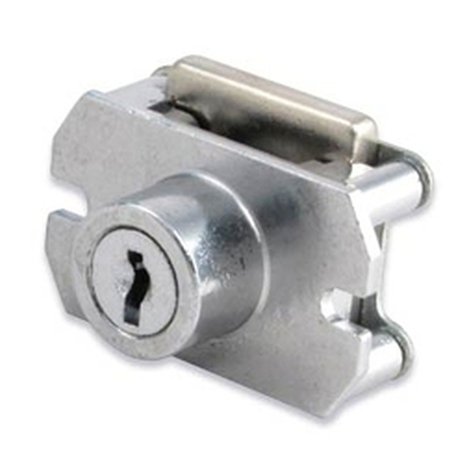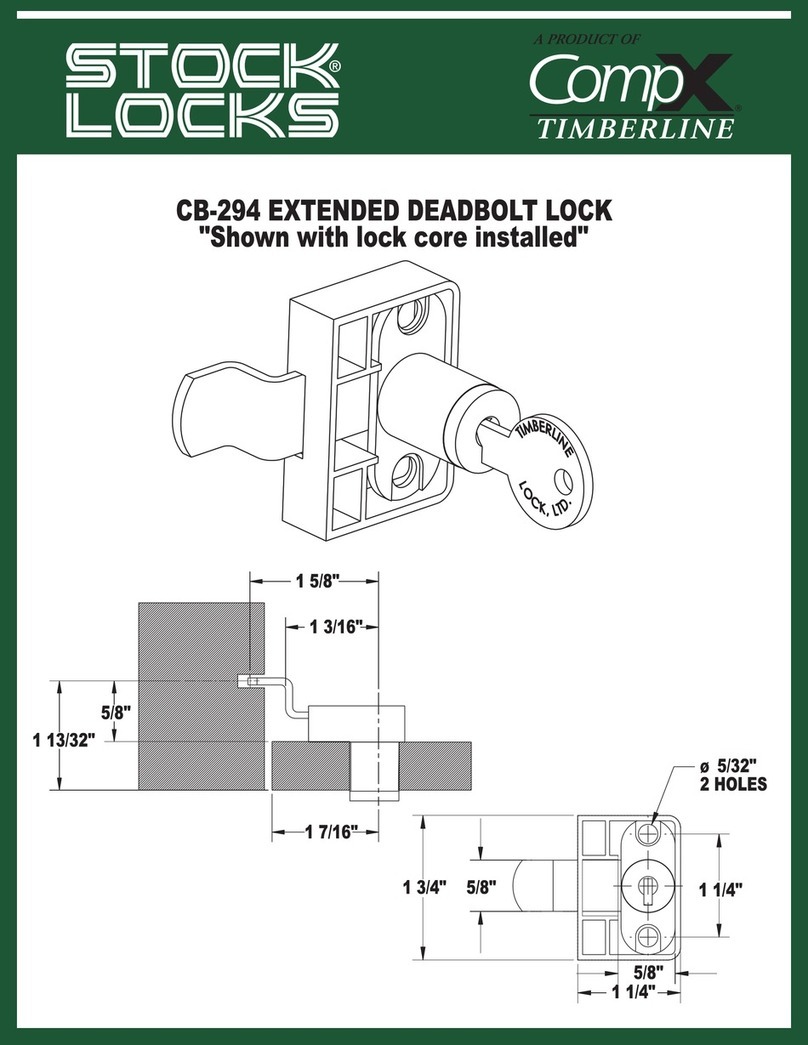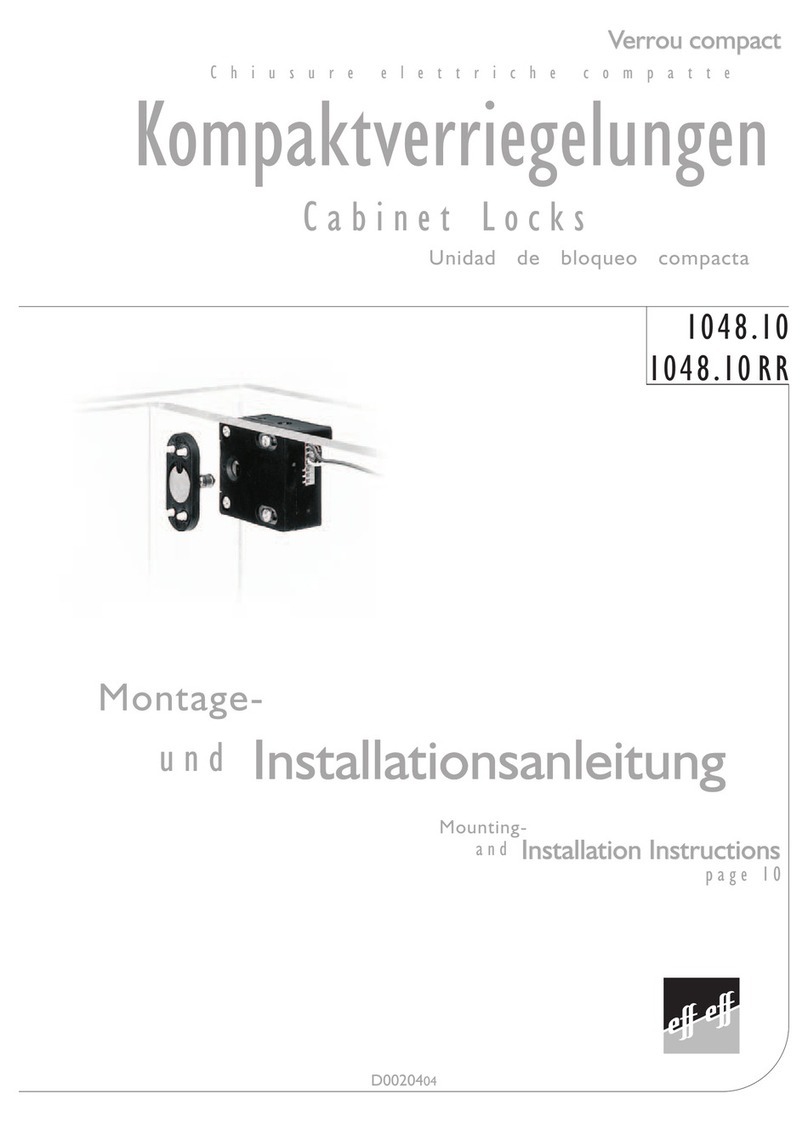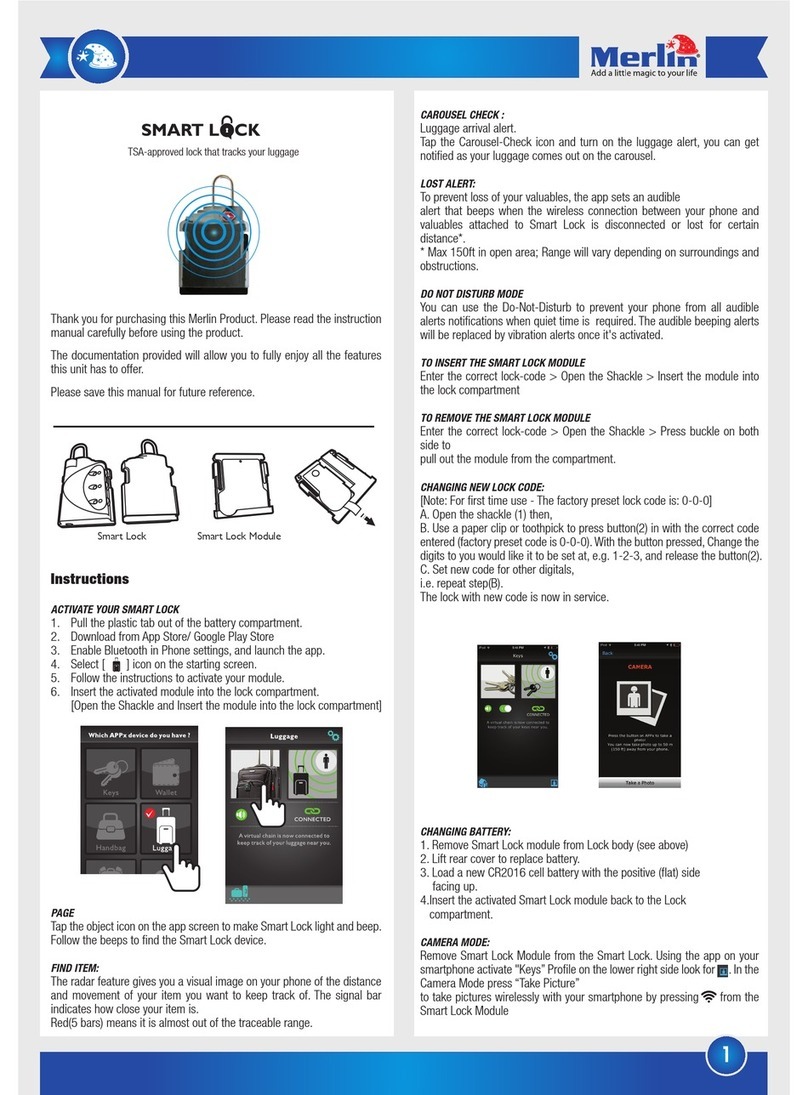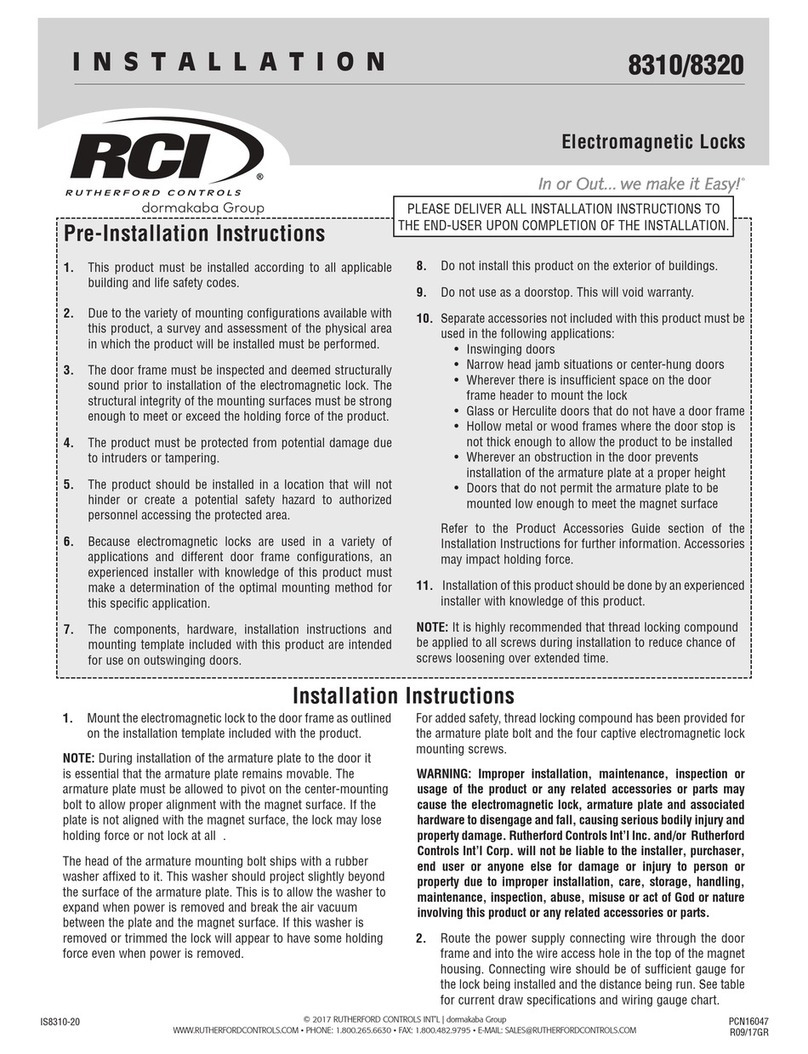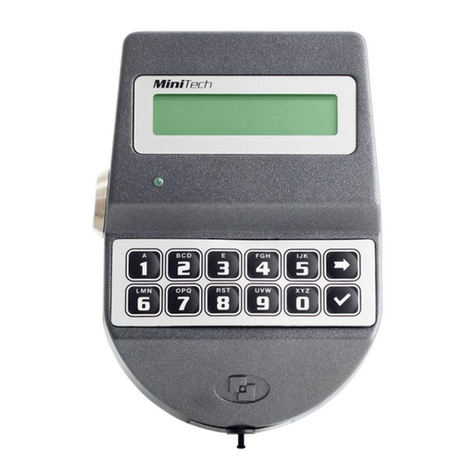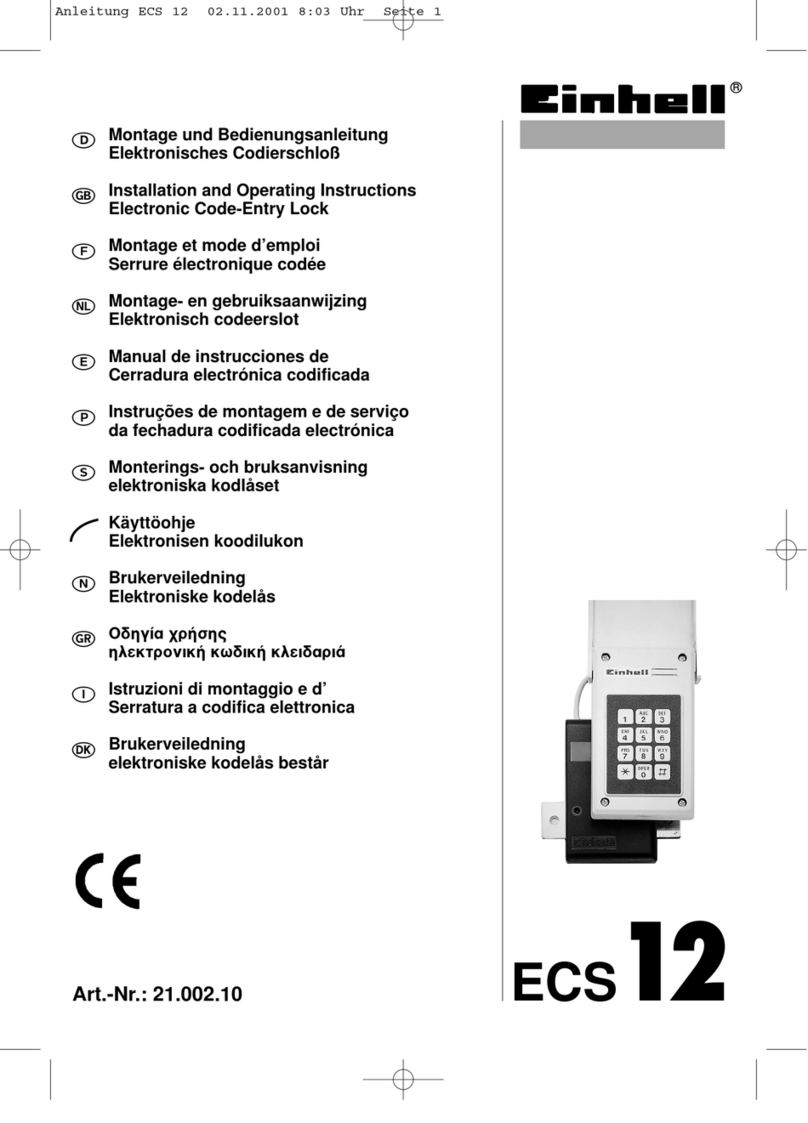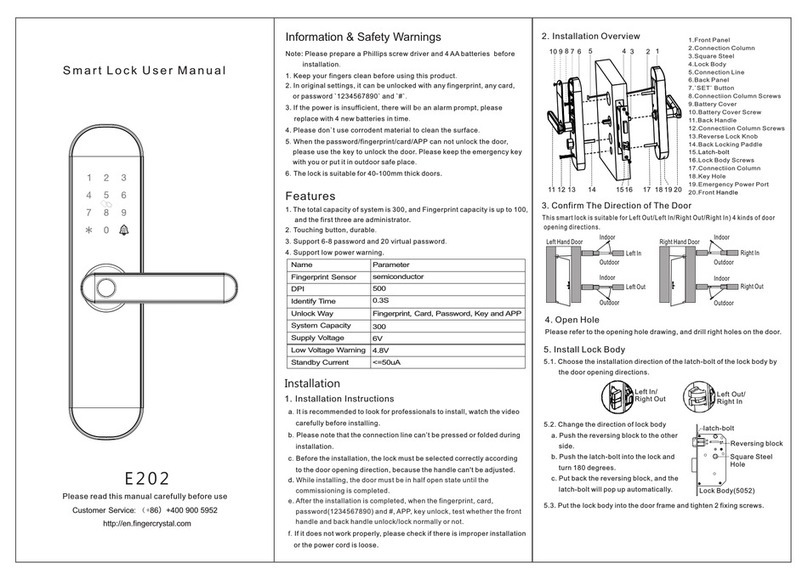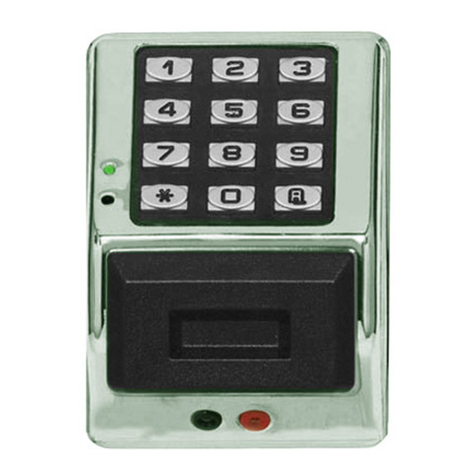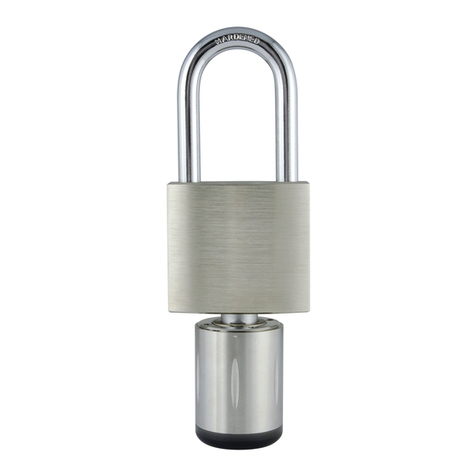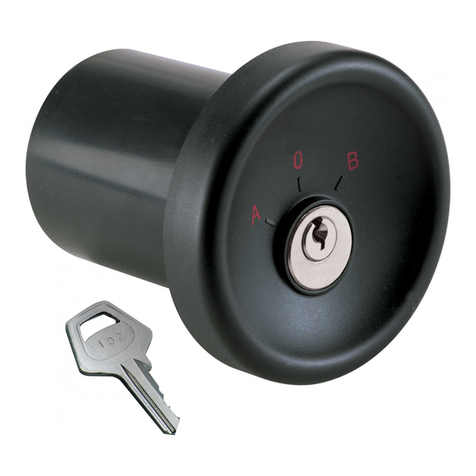Orno OR-ZS-815 User manual

1
OR-ZS-815
(PL) Zamek szyfrowy z czytnikiem kart i breloków zbliżeniowych ID
(EN) Code lock with card and proximity tags reader
(DE) Codeschloss mit Karten- und Proximity-Tags-Leser
ORNO-LOGISTIC Sp. z o.o.
ul. Rolników 437
44-141 Gliwice, POLAND
tel. (+48) 32 43 43 110
(PL) WAŻNE!
Przed rozpoczęciem korzystania z urządzenia, należy zapoznać się z niniejszą instrukcją obsługi oraz zachować ją na przyszłość. Dokonanie samodzielnych napraw i modyfikacji
skutkuje utratą gwarancji. Producent nie odpowiada za uszkodzenia mogące wyniknąć z nieprawidłowego montażu czy eksploatacji urządzenia. Z uwagi na fakt, że dane
techniczne podlegają ciągłym modyfikacjom, Producent zastrzega sobie prawo do dokonywania zmian dotyczących charakterystyki wyrobu oraz wprowadzania innych rozwiązań
konstrukcyjnych niepogarszających parametrów i walorów użytkowych produktu.
Dodatkowe informacje oraz wsparcie techniczne związane z produktem dostępne na: www.support.orno.pl. Orno-Logistic Sp. z o.o. nie ponosi odpowiedzialności za skutki
wynikające z nieprzestrzegania zaleceń niniejszej instrukcji. Firma Orno-Logistic Sp. z o.o. zastrzega sobie prawo do wprowadzania zmian w instrukcji - aktualna wersja do
pobrania ze strony www.support.orno.pl. Wszelkie prawa do tłumaczenia/interpretowania oraz prawa autorskie do niniejszej instrukcji są zastrzeżone.
1. Wszelkie czynności wykonuj przy odłączonym zasilaniu.
2. Nie zanurzaj urządzenia w wodzie i innych płynach.
3. Nie używaj urządzenia niezgodnie z jego przeznaczeniem.
4. Nie obsługuj urządzenia gdy uszkodzona jest obudowa.
5.Nie otwieraj urządzenia i nie dokonuj samodzielnych napraw.
(EN) IMPORTANT!
Before using the device, read this Service Manual and keep it for future use. Any repair or modification carried out by yourselves results in loss of guarantee. The manufacturer is
not responsible for any damage that can result from improper device installation or operation. In view of the fact that the technical data are subject to continuous modifications,
the manufacturer reserves a right to make changes to the product characteristics and to introduce different constructional solutions without deterioration of the product
parameters or functional quality.
Additional information and technical support related to the product is available at: www.support.orno.pl. Orno-Logistic Sp. z o.o. holds no responsibility for the results of non-
compliance with the provisions of the present Manual. Orno Logistic Sp. z o.o. reserves the right to make changes to the Manual - the latest version of the Manual can be
downloaded from www.support.orno.pl. Any translation/interpretation rights and copyright in relation to this Manual are reserved.
1. Disconnect the power supply before any activities on the product.
2. Do not immerse the device in water or other fluids.
3. Do not use the device contrary to its dedication.
4. Do not operate the device if the housing is damaged.
5. Do not open the device and do not repair it by yourselves.
(DE) WICHTIG!
Bevor Sie das Gerät anschließen und benutzen, lesen Sie bitte diese Anleitung sorgfältig durch. Selbständige Reparaturen und Modifikationen führen zum Verlust der Garantie.
Der Hersteller haftet nicht für die Schäden, die aus falscher Montage oder falschem Gebrauch des Geräts folgen können.
In Anbetracht der Tatsache, dass die technischen Daten ständig geändert werden, behält sich der Hersteller das Recht auf Änderungen in Bezug auf Charakteristik des Produktes
und Einführung anderer Konstruktionslösungen, die die Parameter und Gebrauchsfunktionen nicht beeinträchtigen, vor. Weitere Informationen und technische Unterstützung zu
diesem Produkt finden Sie unter: www.support.orno.pl. Orno-Logistic Sp. z o.o. haftet nicht für die Folgen der Nichtbeachtung der Anweisungen in dieser Bedienungsanleitung.
Orno-Logistic Sp. z o.o. behält sich das Recht vor, Änderungen in der Bedienungsanleitung vorzunehmen - aktuelle Version zum Herunterladen unter www.support.orno.pl. Alle
Rechte an Übersetzung/Dolmetschen und Urheberrechten an dieser Bedienungsanleitung sind vorbehalten.
1. Alle Arbeiten dürfen nur bei abgeschalteter Stromversorgung durchgeführt werden.
2. Tauchen Sie das Gerät nicht in Wasser oder andere Flüssigkeiten.
3. Verwenden Sie die Einrichtung nur ordnungsgemäß.
4. Nutzen Sie das Gerät nicht, wenn sein Gehäuse beschädigt ist.
5. Öffnen Sie die Einrichtung nicht und führen Sie keine selbstständigen Reparaturen aus.
Każde gospodarstwo jest użytkownikiem sprzętu elektrycznego i elektronicznego, a co za tym idzie potencjalnym wytwórcą niebezpiecznego dla ludzi i środowiska odpadu,
z tytułu obecności w sprzęcie niebezpiecznych substancji, mieszanin oraz części składowych. Z drugiej strony zużyty sprzęt to cenny materiał, z którego możemy odzyskać surowce takie
jak miedź, cyna, szkło, żelazo i inne. Symbol przekreślonego kosza na śmieci umieszczany na sprzęcie, opakowaniu lub dokumentach do niego dołączonych oznacza, że produktu nie
wolno wyrzucać łącznie z innymi odpadami. Oznakowanie oznacza jednocześnie, że sprzęt został wprowadzony do obrotu po dniu 13 sierpnia 2005 r. Obowiązkiem użytkownika jest
przekazanie zużytego sprzętu do wyznaczonego punktu zbiórki w celu właściwego jego przetworzenia. Informacje o dostępnym systemie zbierania zużytego sprzętu elektrycznego
można znaleźć w punkcie informacyjnym sklepu oraz w urzędzie miasta/gminy. Odpowiednie postępowanie ze zużytym sprzętem zapobiega negatywnym konsekwencjom dla
środowiska naturalnego i ludzkiego zdrowia!
Each household is a user of electrical and electronic equipment, and hence a potential producer of hazardous waste for humans and the environment, due to the presence of hazardous
substances, mixtures and components in the equipment. On the other hand, used equipment is valuable material from which we can recover raw materials such as copper, tin, glass,
iron and others. The weee sign placed on the equipment, packaging or documents attached to it indicates the need for selective collection of waste electrical and electronic equipment.
Products so marked, under penalty of fine, cannot be thrown into ordinary garbage along with other waste. The marking means at the same time that the equipment was placed on the
market after August 13, 2005. It is the responsibility of the user to hand the used equipment to a designated collection point for proper processing. Used equipment can also be handed
over to the seller, if one buys a new product in an amount not greater than the new purchased equipment of the same type. Information on the available collection system of waste
electrical equipment can be found in the information desk of the store and in the municipal office or district office. Proper handling of used equipment prevents negative consequences
for the environment and human health!
Jeder Haushalt ist ein Anwender von Elektro- und Elektronikgeräten und damit ein potenzieller Erzeuger von Abfällen, die für Mensch und Umwelt aufgrund des Vorhandenseins von
gefährlichen Stoffen, Gemischen und Komponenten in den Geräten gefährlich sind. Andererseits sind Altgeräte ein wertvoller Rohstoff, aus dem Rohstoffe wie Kupfer, Zinn, Glas, Eisen
und andere zurückgewonnen werden können. Das Symbol der durchgestrichenen Mülltonne auf der Verpackung, dem Gerät oder den dazugehörigen Dokumenten, weist auf die
Notwendigkeit der getrennten Sammlung von Elektro- und Elektronikaltgeräten hin. Auf diese Weise gekennzeichnete Produkte dürfen unter Strafe nicht zusammen mit anderen
Abfällen entsorgt werden. Die Kennzeichnung weist gleichzeitig darauf hin, dass die Geräte nach dem 13 August 2005 in Verkehr gebracht wurden.
Es liegt in der Verantwortung des Benutzers, die Altgeräte zur ordnungsgemäßen Behandlung an eine dafür vorgesehene Sammelstelle zu bringen. Informationen über das verfügbare
System zur Sammlung von Elektroaltgeräten finden Sie in der Informationsstelle des Ladens und im Magistrat/Gemeindeamt. Ein sachgemäßer Umgang mit Altgeräten verhindert
negative Folgen für die Umwelt und die menschliche Gesundheit!
03/2021

2
PL
Instrukcja obsługi i montażu
OPIS I ZASTOSOWANIE
Zamek szyfrowy OR-ZS-815 jest jednoprzekaźnikowym autonomicznym urządzeniem z klawiaturą kontroli dostępu. Wykorzystano w nim najnowszą technologię
mikroprocesorową do obsługi zamykania drzwi i systemów zabezpieczających, wymagających natychmiastowego zamknięcia (pod względem czasowym) lub zamykania
styku blokującego. Programowanie realizowane jest poprzez klawiaturę numeryczną. Kody i parametry zapamiętywane są w mikroprocesorze i nie tracone przy zaniku
zasilania.
SKŁAD ZESTAWU
1 x klawiatura numeryczna
1 x brelok zbliżeniowy
1 x instrukcja obsługi
1 x zestaw wkrętów do mocowania
SPECYFIKACJA TECHNICZNA
Napięcie nominalne:
12V DC
Liczba użytkowników:
1000
Częstotliwość czytnika:
125kHz
Odległość odczytu karty:
2-6 cm
Pobór prądu w czasie spoczynku:
<20mA
Obciążenie na przekaźniku drzwi:
3A
Obciążenie na wyjściu alarmu:
3A
Klawiatura:
12 klawiszy; 2 x 6 cyfr
Długość kodu PIN:
4-6 cyfr
Pamięć:
EPROM, nieulotna
Kody dostępu:
1 x Kod Master
1000 kart (breloków)
1000 kodów PIN
Dopuszczalna temperatura:
-40℃~60℃
Stopień ochrony:
IP44
Regulacja czasu aktywacji wyjścia (elektrozaczep):
0-99 sekund
Regulacja czasu aktywacji alarmu:
1-3 minut
Waga netto:
0,5kg
MONTAŻ
1. Oddziel podstawę mocującą zamka od pokrywy głównej (w tym celu należy odkręcić śrubę mocującą z dołu zamka).
2. Wywierć otwory i umieść w nich 4 kołki montażowe.
3. Zamocuj tylną płytkę na ścianie.
4. Przewody od zasilania i rygla elektromagnetycznego podłącz do gniazd przyłączeniowych zgodnie ze schematem podłączenia (rys. 3)
5. Zamocuj przednią pokrywę zamka (rys. 2).
Rys.1 Rys.2
Funkcje konektora 1
1
NZ/NC
Pomarańczowy
Styk NZ przekaźnika drzwi
2
WSPÓLNY/COM
Purpurowy
Wspólny styk przekaźnika otwarcia drzwi
3
NO
Niebieski
Styk NO przekaźnika drzwi
4
UZIEMIENIE/GND
Czarny
(-) ujemne wejście regulowane
5
12V
Czerwony
(+) 12 VDC wejście napięcia dodatnie
6
D_IN
Brązowy
Do styku drzwiowego, dalej do bieguna ujemnego
7
OTWARTY/OPEN
Żółty
Przycisk żądania otwarcia drzwi, dalej do bieguna ujemnego
8
ALARM
Szary
Wyłączenie alarmu po uaktywnieniu bieguna ujemnego
Nie podłączać zasilacza do sieci dopóki nie zostaną zakończone prace instalacji wewnętrznej i nie zostanie założona pokrywa przednia
urządzenia.

3
Włączenie zasilania
Po zakończeniu prac instalacji wewnętrznej urządzenia i zabudowie pokrywy przedniej do płyty tylnej należy podać zasilanie. Po podłączeniu zasilania czerwona dioda
LED zacznie migać.
TRYB PROGRAMOWANIA
Zamek szyfrowy może obsługiwać jedno wejście na posesję. Maksymalnie 1000 kart magnetycznych oraz kodów dostępu użytkowników można zaprogramować w
pamięci zamka. Istnieje możliwość zaprogramowania 3 różnych metod aktywacji zamka:
a) wejście na posesję tylko przy pomocy autoryzowanej karty zbliżeniowej ID,
b) wejście na posesję przy pomocy autoryzowanej karty zbliżeniowej oraz cyfrowego kodu dostępu,
c) wejście na posesję przy pomocy autoryzowanej karty zbliżeniowej lub cyfrowego kodu dostępu.
Domyślnie ustawiony kod KOD MASTER (kod administratora) to „9999”. KOD MASTER musi być 4 – 6 cyfrową liczbą.
Kod PIN użytkownika może mieć długość od 4 do 6 cyfr i mieścić się w całym przedziale 0000 - 999999 z wyłączeniem kodu 1, 2, 3, 4
Programowanie użytkowników
Wejście w tryb programowania
W trybie czuwania wpisać (w ciągu 5 sekund):
* Kod Master #
Czerwona dioda LED świeci. Jeżeli w ciągu 30 sekund nie zostanie naciśnięty żaden przycisk,
urządzenie wyjdzie z trybu programowania.
Wyjście z trybu programowania
*
Zmiana kodu Master
0 Nowy Kod Master # Nowy Kod Master # *
Po zaakceptowaniu czerwona dioda LED będzie migać.
Uwaga: Wszystkie poniższe kroki są wykonywane w trybie programowania, tj.(*, kod MASTER, #).
Po każdym kroku, który kończy operację, jeżeli ma być zachowana zmiana i ma nastąpić wyjście z programowania, należy nacisnąć przycisk „*”.
Jeśli chcesz kontynuować programowanie możesz bezpośrednio przejść do następnego kroku, po zakończeniu czynności, naciśnij przycisk „*” zmiana zostanie
zapisana i nastąpi wyjście z trybu programowania.

4
Tryb operacyjny Użytkownika umożliwiający dostęp - (Uwaga:
można wybrać tylko jeden z nich)
Dostęp tylko za pomocą karty (breloka zbliżeniowego)
Dostęp za pomocą karty (breloka zbliżeniowego) oraz kodu PIN
Dostęp za pomocą karty (breloka zbliżeniowego) lub kodu PIN
3 0 0 #
3 0 1 #
3 0 2 # (ustawienie fabryczne)
Aktywacja za pomocą karty (breloka zbliżeniowego) lub kodu PIN (302#)
W tym trybie użytkownik może otworzyć drzwi zarówno przy użyciu karty (breloka) jak i przy użyciu kodu dostępu PIN (alternatywnie). W tym celu należy w trybie
programowania wcisnąć sekwencję klawiszy 302# a następnie dodać użytkowników.
Dodawanie i kasowanie użytkowników w trybie karta (brelok zbliżeniowy) lub kod PIN
Dodawanie kodów dostępu użytkowników
Uwaga: Numer identyfikacyjny użytkownika ID musi być 3
cyfrową liczbą z przedziału 000-999. Nie mylić z kodem dostępu
użytkownika. Numery identyfikacyjne użytkowników muszą być
różne dla każdego breloka. Numer PIN może być dowolną liczbą
4-6 cyfrową z przedziału 0000-999999 z wyjątkiem kodu
„1234”. Użytkowników można dodawać kolejno bez konieczności
każdorazowego wychodzenia z trybu programowania.
1 Numer ID użytkownika # PIN #
1 Numer ID użytkownika 1 # PIN # Numer ID użytkownika 2 # PIN # ... Numer ID użytkownika
„n” # PIN #
Usuwanie kodów dostępu użytkowników
2 Numer ID użytkownika # PIN #
Kody użytkowników można kasować kolejno bez konieczności każdorazowego wychodzenia z
trybu programowania
Zmiana kodu dostępu użytkownika
(poza trybem programowania)
* Numer ID # Stary kod PIN # Nowy kod PIN # Nowy kod PIN #
Dodawanie i kasowanie kart ID użytkownika
Metoda 1
Automatyczne nadawanie numerów ID użytkownikom przez
system
1 Zbliż kartę #
Karty mogą być dodawane kolejno po sobie bez konieczności wychodzenia z trybu
programowania.
Metoda 2
Ręczne nadawanie numerów ID użytkownikom. Tylko 1
użytkownik może być przypisany do pojedynczej karty (breloka
zbliżeniowego).
1 Numer ID # Zbliż kartę #
Kasowanie karty użytkownika przy użyciu karty
2 Zbliż kartę #
Karty mogą być kasowane kolejno po sobie bez konieczności wychodzenia z trybu programowania.
Kasowanie karty użytkownika przy użyciu numeru użytkownika
2 Numer ID #
Dodawanie i kasowanie użytkowników w trybie karta (brelok zbliżeniowy) i kod PIN (301#)
Dodawanie kart ID oraz kodów dostępu użytkowników.
Uwaga: Numer PIN może być dowolną liczbą 4-6 cyfrową z
przedziału 0000-999999 z wyjątkiem kodu „1234”.
Dodaj kartę w taki sam sposób jak w trybie karta lub kod (302#). Wciśnij *, aby opuścić tryb
programowania, a następnie przypisać kod PIN do karty w poniższy sposób: * Zbliż kartę 1234 #
kod PIN # kod PIN #
Zmiana kodu dostępu PIN (można jej dokonać poza trybem programowania, bez udziału administratora systemu)
Metoda 1
* Zbliż kartę Stary kod PIN # Nowy kod PIN # Nowy kod PIN #
Metoda 2
* Numer ID # Stary kod PIN # Nowy kod PIN # Nowy kod PIN #
Kasowanie kodu PIN i karty ID
(wystarczy w tym celu wykasować samą kartę z systemu)
2 Numer ID użytkownika #
Dodawanie i kasowanie użytkowników w trybie tylko karta (brelok zbliżeniowy) 300#
Dodawanie lub kasowanie użytkownika
Postępować w identyczny sposób jak dla trybie karta lub kod (302#)
Usuwanie wszystkich użytkowników
2 0000 #
2. Ustawienie czasu aktywacji rygla
Istnieje możliwość zaprogramowania zamka szyfrowego aby pracował w jednym z dwóch trybów aktywacji przekaźnika: tryb monostabilny i bistabilny.
TRYB MONOSTABILNY
4 Czas 0~99 sekund #
Jest to tryb ustawiony domyślnie. Po zbliżeniu do czytnika ważnej karty (breloka zbliżeniowego) lub wprowadzeniu ważnego kodu dostępu, rygiel na wyjściu
przekaźnika zostanie zwolniony na zaprogramowany wcześniej okres czasu, po czym zostanie ponownie zablokowany do momentu ponownego zbliżenia ważnej karty
(breloka zbliżeniowego) lub wprowadzenia poprawnego kodu dostępu. Ustawienie fabryczne wynosi 6 sekund. Istnieje możliwość wprowadzenia wartości w zakresie
od 1 do 99 sekund.
TRYB BISTABILNY
4 0 #
Jest to tryb, w którym po zbliżeniu do czytnika ważnej karty (breloka zbliżeniowego) lub po wprowadzeniu ważnego kodu dostępu, rygiel na wyjściu przekaźnika zostaje
zwolniony i pozostaje w tym stanie aż do momentu ponownego zbliżenia ważnej karty ID lub wprowadzenia poprawnego kodu dostępu (karta/kod naprzemiennie
zwalniają i blokują rygiel sterujący wejściem na posesję).
Regulacja czasu trwania alarmu
Ustawienie fabryczne wynosi 3 minuty.
Istnieje możliwość wprowadzenia wartości w zakresie od 1 do 3
minut.
5 1~3 #
Ustawienie czujnika wykrywania otwarcia drzwi
Aby móc skorzystać z funkcji należy podłączyć do zamka
magnetycznego czujnik otwartych drzwi (kontrakton) a następnie
w trybie programowania wybrać jedną z sekwencji:
6 0 0 # wyłączenie funkcji (nastawienie fabryczne)
6 0 1 # włączenie funkcji
Istnieją 2 funkcje programowania działające w tym trybie.
a. Jeżeli drzwi nie zostaną zamknięte po otwarciu, zacznie działać brzęczyk klawiatury.
b. Jeżeli drzwi zostały otwarte przy użyciu siły, zacznie działać brzęczyk klawiatury i uruchomi się
dźwięk alarmu

5
Ustawienie funkcji zabezpieczeń
Istnieją dwie możliwości zabezpieczania klawiatury urządzenia:
7 0 1 # odczyt 10 nieważnych kart lub wprowadzenie kolejno 4 niewłaściwych kodów dostępu
(PIN) powoduje zablokowanie klawiatury na 10 minut.
7 0 1 # odczyt 10 nieważnych kart lub wprowadzenie kolejno 4 niewłaściwych haseł powoduje
włączenie brzęczyka klawiatury i uaktywnienie sygnału alarmu.
7 0 0 # wyłączenie funkcji, nastawienie fabryczne, nie kasuje użytkowników
Reset urządzenia do ustawień fabrycznych
W celu zresetowania urządzenia należy nacisnąć i przytrzymać na klawiaturze przycisk * i podłączyć do prądu. Usłyszysz trzy sygnały dźwiękowe (dwa krótkie i jeden
długi) co będzie oznaczało, że reset urządzenia został przeprowadzony prawidłowo. Długi sygnał dźwiękowy pojawi się po zwolnieniu przycisku.
Reset urządzenia nie kasuje użytkowników ale kasuje MASTER CODE.
EN
Operating and installation instructions
DESCRIPTION
OR-ZS-815 code lock is a single-relay standalone device with an access control keypad. It uses the newest microprocessor technology to handle the locking of doors
and security systems that require immediate closing (in terms of time) or closing of the locking contact. Programming is carried out via the numeric keypad. Codes and
parameters are stored in the microprocessor and cannot be lost during a power failure.
ELEMENTS OF THE SET
1 x Keypad
1 x Proximity tag
1 x User manual
1 x Set of fastening screws
TECHNICAL SPECIFICATION
Operating voltage:
12V DC
User capacity:
1000
Reader frequency:
125kHz
Card reading distance:
2-6 cm
Power consumption at rest:
<20mA
Lock output load:
3A
Alarm output load:
3A
Keypad:
12 buttons; 2 x 6 digits
PIN length:
4-6 digits
Storage:
EPROM
Access codes:
1 x Master Code
1000 cards (proximity tags)
1000 PIN codes
Operating temperature:
-40℃~60℃
Ingress protection:
IP44
Adjustable door relay time:
0-99 seconds
Adjustable alarm time:
1-3 minutes
Net weight:
0.5kg
INSTALLATION
1. Separate the base of the code lock from the main cover (to do this, unscrew the fastening screw on the bottom of the code lock).
2. Drill holes and place 4 mounting dowels in them.
3. Fix the back plate on the wall.
4. Connect the wires from power supply and electromagnetic lock to the terminal blocks according to the wiring diagram (Fig. 3).
5. Fix the front cover of code lock (fig. 2).
Fig.1 Fig.2
Connector 1 functions
1
NZ/NC
Orange
Door relay NZ contact
2
COM
Purple
Common contact for door open relay
3
NO
Blue
Door relay NO contact
4
GND
Black
(-)negative adjustable input
5
12V
Red
(+) 12 VDC positive voltage input
6
D_IN
Brown
To the door contact, further to the negative pole
7
OPEN
Yellow
Door open request button, further to the negative pole
8
ALARM
Grey
Alarm deactivation when the negative pole is activated
Do not connect the power supply unit to the mains until the internal installation work has been completed and the front cover of the unit has been
fitted.

6
Switching on the power supply
After completing the internal installation work of the unit and fitting the front cover to the back plate, the power supply must be applied. When power is applied, the
red LED will flash.
PROGRAMMING MODE
The code lock can operate one entrance to the premises. Up to 1000 cards and user access codes can be programmed in the lock memory.
Three different lock activation methods can be programmed:
a) Entry to the property only with an authorised proximity ID card,
b) Entry to the property by means of an authorised proximity card and a digital access code,
c) Entry to the property by means of an authorised proximity card or digital access code.
The default MASTER CODE (administrator code) is "9999". MASTER CODE must be a 4 - 6 digit number.
User PIN code can be 4 - 6 digits long and can be in the whole range 0000 - 999999 excluding code 1, 2, 3, 4
User programming
To enter programming mode
In standby mode, enter (within 5 seconds):
* Master code #
The red LED lights up. If no button is pressed within 30 seconds, the device will exit
programming mode.
Exit programming mode
*
Change of Master code
0 New Master Code # New Master code # *
Once accepted, the red LED will flash.
Note: All the following steps are performed in programming mode, i.e.(*, MASTER code, #).
After each step that completes the operation, if the change is to be saved and the programming is to be exited, press the "*" button.
If you want to continue the programming you can go directly to the next step, after completing the operation, press the "*" button the change will be saved and you
will exit the programming mode.

7
User operation mode for access –(Note: only one can be selected)
Access only with card (proximity tag)
Access by card (proximity tag) and PIN code
Access by card (proximity tag) or PIN code
3 0 0 #
3 0 1 #
3 0 2 # (Factory default)
Activation by card (proximity tag) or PIN code (302#)
In this mode, the user can open the door either with a card (proximity tag) or with an access code PIN (alternatively). To do this, press the key sequence 302# in
programming mode and then add users.
Add and delete users in card (proximity tag) or PIN mode
Adding user access codes
Note: The user ID number must be a 3 digit number between 000-999.
Not to be confused with the user access code. User ID numbers must be
different for each proximity tag. The PIN number can be any 4-6 digit
number in the range 0000-999999 except the code "1234". Users can be
added sequentially without having to exit programming mode each time.
1 User ID number # PIN code #
1 User ID number 1 # PIN code # User ID number 2 # PIN code # ... User ID number
„n” # PIN code #
Deleting user access codes
2 User ID number # PIN code #
User codes can be deleted one by one without having to exit the programming mode
each time
Changing the user access code
(outside programming mode)
* User ID number # Old PIN code # New PIN code # New PIN code #
Adding and deleting user ID cards
Method 1
Automatic assignment of ID numbers to users by the system
1 Read card #
Cards can be added sequentially without having to leave programming mode.
Method 2
Manual assignment of ID numbers to users. Only 1 user can be assigned to
a single card (proximity tag).
1 ID number # Read card #
Deleting the user card with the card
2 Read card #
Cards can be deleted consecutively without having to leave the programming mode.
Deleting the user card using the user number
2 ID number #
Adding and deleting users in card (proximity tag) and PIN mode (301#)
Adding ID cards and user access codes
Note: The PIN number can be any 4-6 digit number between 0000-
999999 except for the code "1234".
Add a card in the same way as in card or code mode (302#). Press * to exit programming
mode, then assign a PIN to the card as follows: * Read card 1234 # PIN code # PIN code
#
Changing the PIN access code (can be done outside the programming mode, without the involvement of the system administrator)
Method 1
* Read card Old PIN code # New PIN code # New PIN code #
Method 2
* ID Number # Old PIN code # New PIN code # New PIN code #
Deleting PIN code and ID card
(simply delete the card itself from the system for this purpose)
2 User ID Number #
Adding and deleting users in card-only mode (proximity tag) 300#
Adding or deleting a user
Proceed in the same way as in the card or code mode (302#)
Deleting all users
2 0000 #
2. Setting of the lock activation time
It is possible to program the code lock to operate in one of two relay activation modes: monostable and bistable.
MONOSTABLE MODE
4 0~99 seconds #
This is the mode set by default. When a valid card (proximity tag) is placed close to the reader or a valid access code is entered, the output relay's latch is released for a
pre-programmed time period and then locked again until a valid card (proximity tag) is brought close again or a valid access code is entered. The factory setting is 6
seconds. You can enter a value between 1 and 99 seconds.
BISTABLE MODE
4 0 #
In this mode, when a valid proximity card (proximity tag) is brought close to the reader or a valid access code is entered, the exit bolt on the relay is released and
remains in this state until a valid ID card is brought close again or a valid access code is entered (the card/code alternately releases and locks the entry bolt).
Adjusting the alarm duration
The factory setting is 3 minutes.
You can enter a value between 1 and 3 minutes.
5 1~3 #
Door opening detector setting
To be able to use the function, connect the open door sensor (contracton)
to the magnetic lock and then select one of the sequences in the
programming mode:
6 0 0 # deactivation of the function (factory setting)
6 0 1 # actvation of the function
There are 2 programming functions that operate in this mode.
a. If the door is not closed when opened, the keypad buzzer will operate.
b. If the door has been forcibly opened, the keypad buzzer will sound and the alarm will
sound
Security function setting
There are two options for securing the device's keypad:
7 0 1 # reading 10 invalid cards or entering 4 wrong access codes (PIN) consecutively
causes the keypad to lock for 10 minutes.
7 0 1 # reading 10 invalid cards or entering 4 wrong passwords consecutively causes
the keypad buzzer to sound and the alarm signal to be activated.
7 0 0 # deactivation of function, factory setting, no deletion of users
Reset the device to factory settings
To reset the device, press and hold the * button on the keypad and connect to the power supply. You will hear three beeps (two short beeps and one long beep) to
indicate that the device has been reset correctly. A long beep will sound when the button is released.
Resetting the device does not delete the users but deletes the MASTER CODE.

8
DE
Bedienungs- und Montageanleitung
BESCHREIBUNG
Das Codeschloss OR-ZS-815 ist ein Ein-Relais-Standalone-Gerät mit einer Zutrittskontrolltastatur. Es verwendet die neueste Mikroprozessor-Technologie, um die
Verriegelung von Türen und Sicherheitssystemen zu handhaben, die ein sofortiges Schließen (in Bezug auf die Zeit) oder das Schließen des Schließkontakts erfordern.
Die Programmierung erfolgt über das numerische Tastenfeld. Codes und Parameter werden im Mikroprozessor gespeichert und können bei einem Stromausfall nicht
verloren gehen.
ZUSAMMENSETZUNG DES BAUSATZES
1 x Tastenfeld
1 x Proximity-Tag
1 x Bedienungsanleitung
1 x Satz Befestigungsschrauben
TECHNISCHE DATEN
Nennspannung:
12V DC
Anzahl der Benutzer:
1000
Leserfrequenz:
125kHz
Lesedistanz der Karte:
2-6 cm
Stromverbrauch im Ruhezustand:
<20mA
Belastung des Türrelais:
3A
Belastung am Alarmausgang:
3A
Tastenfeld:
12 Tasten; 2 x 6 Ziffern
PIN-Länge:
4-6 Ziffern
Speicher:
EPROM
Zugangscodes:
1 x Master-Code
1000 Karten (Proximity Tags)
1000 PIN-Codes
Zulässige Temperatur:
-40℃~60℃
Schutzart:
IP44
Einstellung der Ausgangsaktivierungszeit (elektrischer Türöffner):
0-99 Sekunden
Einstellbare Alarmaktivierungszeit:
1-3 Minuten
Nettogewicht:
0,5kg
MONTAGE
1. Trennen Sie den Boden der Schlossabdeckung von der Hauptabdeckung (entfernen Sie dazu die Befestigungsschraube an der Unterseite des Schlosses).
2. Bohren Sie Löcher und setzen Sie 4 Befestigungsbolzen in die Löcher.
3. Befestigen Sie die Rückplatte an der Wand.
4. Schließen Sie die Drähte von der Stromversorgung und der elektromagnetischen Verriegelung an die Klemmenblöcke gemäß dem Schaltplan an (Abb. 3).
5. Bringen Sie die vordere Schlossabdeckung an (Abb. 2).
Abb.1 Abb.2
Funktionen des Steckers 1
1
NZ/NC
Orange
Türrelais NZ-Kontakt
2
COM
Violett
Gemeinsamer Kontakt für Türöffnungsrelais
3
NO
Blau
Türrelais NO-Kontakt
4
GND
Schwarz
(-)negativer einstellbarer Eingang
5
12V
Rot
(+) 12 VDC positiver Eingangsspannung
6
D_IN
Braun
Zum Türkontakt, weiter zum Minuspol
7
OPEN
Gelb
Taste zur Anforderung der Türöffnung, weiter zum Minuspol
8
ALARM
Grau
Alarmdeaktivierung bei Aktivierung des Minuspols
Schließen Sie das Netzteil erst dann an das Netz an, wenn die internen Installationsarbeiten abgeschlossen sind und die Frontabdeckung des
Geräts montiert ist.

9
Einschalten der Stromversorgung
Nach Abschluss der geräteinternen Installationsarbeiten und der Montage der Frontabdeckung an der Rückseite muss die Spannungsversorgung angelegt werden.
Beim Anlegen der Spannungsversorgung blinkt die rote LED.
PROGRAMMIERMODUS
Das Codeschloss kann einen Eingang zu den Räumen bedienen. Bis zu 1000 Karten und Benutzerzugangscodes können im Schlossspeicher programmiert werden.
Es können drei verschiedene Methoden zur Aktivierung des Schlosses programmiert werden:
a) Eingang zum Grundstück nur mit einer autorisierten Proximity-ID-Karte,
b) Eingang zum Grundstück mit einer autorisierten Proximity-Karte und einem digitalen Zugangscode,
c) Eingang zum Grundstück mittels einer berechtigten Proximity-Karte oder eines digitalen Zugangscodes.
Der voreingestellte MASTER CODE (Administratorcode) ist "9999". MASTER CODE muss eine 4 - 6-stellige Zahl sein.
Der Benutzer-PIN-Code kann 4 - 6 Ziffern lang sein und im gesamten Bereich 0000 - 999999 liegen, mit Ausnahme von Code 1, 2, 3, 4

10
Benutzerprogrammierung
Eintritt in den Programmiermodus
Geben Sie im Standby-Modus ein (innerhalb von 5 Sekunden):
* Master-Code #
Die rote LED leuchtet. Wenn innerhalb von 30 Sekunden keine Taste gedrückt wird,
verlässt das Gerät den Programmiermodus.
Verlassen des Programmiermodus
*
Änderung des Master-Codes
0 Neuer Master-Code #Neuer Master-Code #*
Nach der Annahme blinkt die rote LED.
Hinweis: Alle folgenden Schritte werden im Programmiermodus durchgeführt, (*, MASTER-Code, #).
Nach jedem Schritt, der den Vorgang abschließt, wenn die Änderung gespeichert und die Programmierung verlassen werden soll, drücken Sie die Taste " * ".
Wenn Sie die Programmierung fortsetzen wollen, können Sie direkt zum nächsten Schritt übergehen. Nach Abschluss des Vorgangs, drücken Sie die Taste " * ", die
Änderung wird gespeichert und Sie verlassen den Programmiermodus.
Benutzerbetriebsart für den Zugriff - (Hinweis: Es kann nur eine
ausgewählt werden)
Zugang nur mit Karte (Proximity Tag)
Zugang mit Karte (Proximity Tag) und PIN-Code
Zugang mit Karte (Proximity Tag) oder PIN-Code
3 0 0 #
3 0 1 #
3 0 2 # (Werkseinstellung)
Aktivierung per Karte (Proximity Tag) oder PIN-Code (302#)
In diesem Modus kann der Benutzer die Tür entweder mit einer Karte (Proximity Tag) oder mit einem Zugangscode-PIN (alternativ) öffnen. Drücken Sie dazu im
Programmiermodus die Tastenfolge 302# und fügen Sie dann Benutzer hinzu.
Add and delete users in card (proximity tag) or PIN mode
Hinzufügen von Benutzer-Zugangscodes
Hinweis: Die Benutzer-ID-Nummer muss eine 3-stellige Zahl zwischen
000-999 sein. Nicht zu verwechseln mit dem Benutzer-Zugangscode. Die
Benutzer-ID-Nummern müssen für jeden Proximity-Tag unterschiedlich
sein. Die PIN-Nummer kann eine beliebige 4-6-stellige Zahl im Bereich
0000-999999 sein, außer dem Code "1234". Benutzer können
nacheinander hinzugefügt werden, ohne jedes Mal den
Programmiermodus verlassen zu müssen.
1 Benutzer-ID-Nummer # PIN-Code #
1 Benutzer-ID-Nummer 1 # PIN-Code # Benutzer-ID-Nummer 2 # PIN-Code #...
Benutzer-ID-Nummer „n” # PIN-Code #
Löschen von Benutzer-Zugangscodes
2 Benutzer-ID-Nummer # PIN-Code #
Benutzercodes können nacheinander gelöscht werden, ohne dass der
Programmiermodus jedes Mal verlassen werden muss
Ändern des Benutzerzugangscodes
(außerhalb des Programmiermodus)
* Benutzer-ID-Nummer # Alter PIN-Code # Neuer PIN-Code # Neuer PIN-Code #
Hinzufügen und Löschen von Benutzer-ID-Karten
Methode 1
Automatische Zuordnung von ID-Nummern zu Benutzern durch das
System
1 Karte lesen #
Karten können nacheinander hinzugefügt werden, ohne dass der Programmiermodus
verlassen werden muss.
Methode 2
Manuelle Zuordnung von ID-Nummern zu Benutzern. Einer einzelnen
Karte (Proximity Tag) kann nur 1 Benutzer zugewiesen werden.
1 ID-Nummer # Karte lesen #
Löschen der Benutzerkarte mit der Karte
2 Karte lesen #
Karten können nacheinander gelöscht werden, ohne den Programmiermodus verlassen
zu müssen.
Löschen der Benutzerkarte über die Benutzernummer
2 ID-Nummer #
Hinzufügen und Löschen von Benutzern im Karten- (Proximity Tag) und PIN-Modus (301#)
Hinzufügen von ID-Karten und Benutzerzugangscodes
Hinweis: Die PIN-Nummer kann eine beliebige 4-6-stellige Zahl zwischen
0000-999999 sein, außer dem Code "1234".
Fügen Sie eine Karte auf die gleiche Weise wie im Karten- oder Codemodus hinzu
(302#). Drücken Sie *, um den Programmiermodus zu verlassen, und weisen Sie der
Karte dann wie folgt eine PIN zu: * Karte lesen 1234 # PIN-Code # PIN-Code #
Ändern des PIN-Zugangscodes (kann außerhalb des Programmiermodus, ohne Beteiligung des Systemadministrators erfolgen)
Methode 1
* Karte lesen Alter PIN-Code # Neuer PIN-Code # Neuer PIN-Code #
Methode 2
* ID-Nummer # Alter PIN-Code # Neuer PIN-Code # Neuer PIN-Code #
PIN-Code und ID-Karte löschen
(löschen Sie dazu einfach die Karte selbst aus dem System)
2 Benutzer-ID-Nummer #
Hinzufügen und Löschen von Benutzern im Nur-Karten-Modus (Proximity Tag) 300#
Hinzufügen oder Löschen eines Benutzers
Gehen Sie genauso vor wie im Karten- oder Codemodus (302#)
Alle Benutzer löschen
2 0000 #
2. Einstellung der Aktivierungszeit der Sperre
Es ist möglich, das Codeschloss so zu programmieren, dass es in einem von zwei Relaisaktivierungsmodi arbeitet: monostabil und bistabil.
MONOSTABILER MODUS
4 0~99 Sekunden #
Dies ist der werkseitig eingestellte Modus. Wenn eine gültige Karte (Proximity-Tag) in die Nähe des Lesers gebracht oder ein gültiger Zugangscode eingegeben wird,
wird die Verriegelung des Ausgangsrelais für eine vorprogrammierte Zeitspanne freigegeben und dann wieder gesperrt, bis erneut eine gültige Karte (Proximity-Tag) in
die Nähe gebracht oder ein gültiger Zugangscode eingegeben wird. Die Werkseinstellung ist 6 Sekunden. Sie können einen Wert zwischen 1 und 99 Sekunden
eingeben.
BISTABILER MODUS
4 0 #
Wenn in diesem Modus eine gültige Proximity-Karte (Proximity-Tag) in die Nähe des Lesers gebracht oder ein gültiger Zugangscode eingegeben wird, wird der
Ausgangsriegel am Relais freigegeben und bleibt in diesem Zustand, bis erneut eine gültige ID-Karte in die Nähe gebracht oder ein gültiger Zugangscode eingegeben
wird (die Karte/der Code gibt den Eingangsriegel abwechselnd frei und sperrt ihn).
Einstellen der Alarmdauer
Die Werkseinstellung ist 3 Minuten.
Sie können einen Wert zwischen 1 und 3 Minuten eingeben.
5 1~3 #
Einstellung des Türöffnungsmelders
Um die Funktion nutzen zu können, schließen Sie den Türöffnungssensor
(Kontrakton) an das Magnetschloss an und wählen dann im
Programmiermodus eine der Sequenzen aus:
6 0 0 # Deaktivierung der Funktion (Werkseinstellung)
6 0 1 # Aktivierung der Funktion
Es gibt 2 Programmierfunktionen, die in diesem Modus arbeiten:

11
a. Wenn die Tür beim Öffnen nicht geschlossen ist, wird der Tastatursummer aktiviert.
b. Wenn die Tür gewaltsam geöffnet wurde, ertönt der Tastatursummer und der Alarm
wird ausgelöst
Einstellung der Sicherheitsfunktion
Es gibt zwei Möglichkeiten, das Tastenfeld des Geräts zu sichern:
7 0 1 # Das Lesen von 10 ungültigen Karten oder die Eingabe von 4 falschen
Zugangscodes (PIN) nacheinander führt zur Sperrung der Tastatur für 10 Minuten.
7 0 1 # Das Lesen von 10 ungültigen Karten oder die Eingabe von 4 falschen Codes
nacheinander löst den Tastatursummer aus und aktiviert das Alarmsignal.
7 0 0 # Deaktivieren der Funktion, Werkseinstellung, löscht keine Benutzer.
Zurücksetzen des Geräts auf Werkseinstellungen
Um das Gerät zurückzusetzen, halten Sie die Taste * auf dem Tastenfeld gedrückt und schließen Sie es an die Stromversorgung an. Sie hören drei Signaltöne (zwei
kurze Signaltöne und einen langen Signalton), um anzuzeigen, dass das Gerät korrekt zurückgesetzt wurde. Ein langer Signalton ertönt, wenn die Taste losgelassen wird.
Das Zurücksetzen des Geräts löscht nicht die Benutzer, sondern löscht den MASTER CODE.
Table of contents
Languages:
Other Orno Lock manuals






